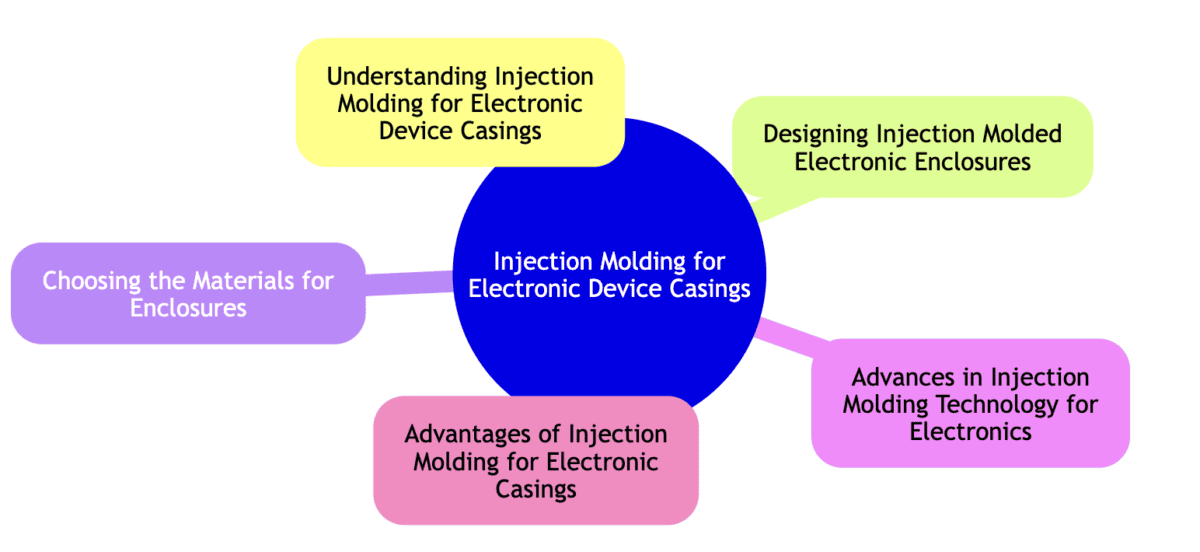Introduction to Injection Molding for Electronic Device Casings
Injection molding is the go-to solution for producing long-lasting electronic device casings.
This manufacturing process allows for quick and efficient production of intricate plastic parts (tailored to withstand specified conditions like heat or cold) in mass quantities, precisely crafted.
This article from injection molding company JDI Plastics discusses the advantages we offer for the electronics sector. Our injection molding processes provide cases that are top quality, just like our customer service. Call today!
Key Points to Remember
- Injection molding provides accuracy and robustness for electronic device casings.
- Choosing the material is vital for functionality and longevity.
- Design factors to consider include managing heat distribution and protecting against interference.
- Mass production benefits from cost-effectiveness and uniformity.
- Advancements in materials and techniques improve casing performance.

Understanding Injection Molding for Electronic Device Casings
Injection molding entails injecting material into a mold to create components, including electronic device casings. Manufacturers prefer this technique because it can produce shapes with accuracy and consistency, which is essential in maintaining electronic products’ uniformity.
The process involves designing the component, crafting the mold, injecting the material, cooling it down, and then removing the product.
The application of injection molding significantly enhances electronic device casings due to the availability of engineering plastics like ABS, polycarbonate, nylon, polyphthalamide and many other specialized materials.
ABS is recognized for its durability and ability to withstand impacts, making it a great choice for cases.
Polycarbonate, on the other hand, offers both high-impact resistance and transparency, which is particularly beneficial for cases needing to display internal components.
Each material has features that improve enclosure functionality, including thermal regulation, volume resistivity, dielectric strength, arc resistance, mechanical robustness and many more. (1)
Designing Injection Molded Electronic Enclosures
Designing Injection-molded electronic enclosures requires consideration of key elements to ensure optimal performance and longevity.
The design should address integrity, thermal management, and electromagnetic shielding to safeguard the components effectively.
- Structural Integrity: The enclosure should withstand impacts and environmental strains. Introducing ribs and bosses can bolster strength without adding weight.
- Thermal Management: Efficient heat dissipation is crucial in preventing overheating. Incorporating vents, heat sinks, or thermal pads can help manage and dissipate heat effectively.
- Electromagnetic Shielding: To shield against interference from parts, consider using coatings or integrating metal inserts to block electromagnetic waves.
- Ease of Assembly: Design the enclosure with assembly and maintenance in mind. When putting together a product using features like snap fits, hinges, and interlocking tabs can make the assembly process easier.
- Aesthetic Considerations: Visual appeal is important, too. Make sure that the design matches the desired appearance by choosing surface finishes, colors, and textures that align with the product’s branding and user expectations.
Choosing the Materials for Enclosures
ABS (Acrylonitrile Butadiene Styrene)
ABS is tough, resistant to impacts, and cost-effective, making it a great choice. It’s effective and common in enclosures because of its durability and ability to withstand impacts without breaking.
Polycarbonate (PC)
Polycarbonate offers high impact resistance and transparency, making it ideal for enclosures where visibility of components is needed. It also has stability and can endure tough environmental conditions, making it popular for many electronic devices.
HDPE (High-Density Polyethylene)
HDPE is valued for its strong chemical resistance and low moisture absorption, making it perfect for challenging environments. This material is found in applications where the enclosure needs to resist exposure to chemicals and moisture without deteriorating.
Polyphthalamide (PPA)
PPA is known for its durability and resistance to electricity. While more expensive than many other materials, it offers plenty of use cases- especially in growing industries such as the electric portion of automotives.
There are many other materials that have uses in the electronics industry as well, which is why it is important to partner with an expert to spec the right material for what you are trying to accomplish.
Advances in Injection Molding Technology for Electronics
Recent progress in injection molding has greatly enhanced the manufacturing of casings. Improved mold design techniques, superior material characteristics, and intelligent production methods drive these advancements.
Noteworthy Technological Progress
- Innovative Mold Design: Using simulation tools to create optimized molds ensures precision and efficiency.
- Upgraded Materials: Newly developed polymers offer enhanced thermal, mechanical, and electrical properties, making them well-suited for electronic casings.
- Intelligent Manufacturing: Integration of IoT and automation enables precise control and monitoring, resulting in high quality and consistency.
- Fusion Techniques: Blending traditional and additive manufacturing approaches boosts flexibility and customization options.
- Environmentally Friendly Practices: Sustainable materials and waste reduction measures contribute to eco-conscious manufacturing processes.
Advantages of Injection Molding for Electronic Casings
Injection molding provides benefits for casings, such as high accuracy, scalability, and material adaptability. This method enables the production of complex shapes with consistent quality, making it a favorable choice for large-scale manufacturing.
Comparison of Key Materials
| Material | Strength | Temperature Resistance | Cost |
| ABS | High | Moderate | Low |
| Polycarbonate | Very High | High | Moderate |
| HDPE | Moderate | Very High | Low |
| Polyphthalamide | Very High | Very High | High |
Moving Forward: Injection molding for Electronic Casing
Injection molding has made electronic casing a quick and easy process. Once the design is made, injection molding companies like JDI Plastics can provide businesses with the highest quality injection molded cases.
We have the technology and expertise to produce exceptional plastic injected parts for any industry. We can help with prototyping or mass production of final products.
JDI Plastics is happy to answer any questions.
Please explore our website HERE and contact us today with any questions!
Reference:
(1) IQS Directory, Electronic Enclosures, https://www.iqsdirectory.com/articles/electronic-enclosure.html#:~:text=Electronic%20enclosures%20are%20box%2Dlike,power%20supplies%2C%20processors%2C%20etc.
